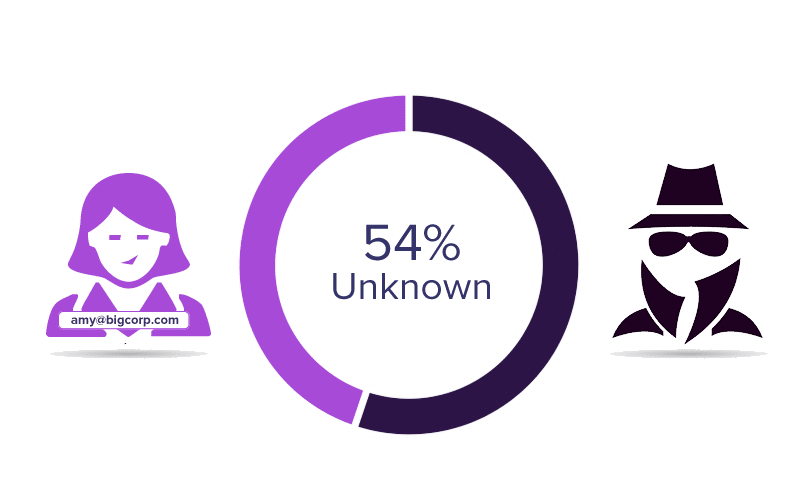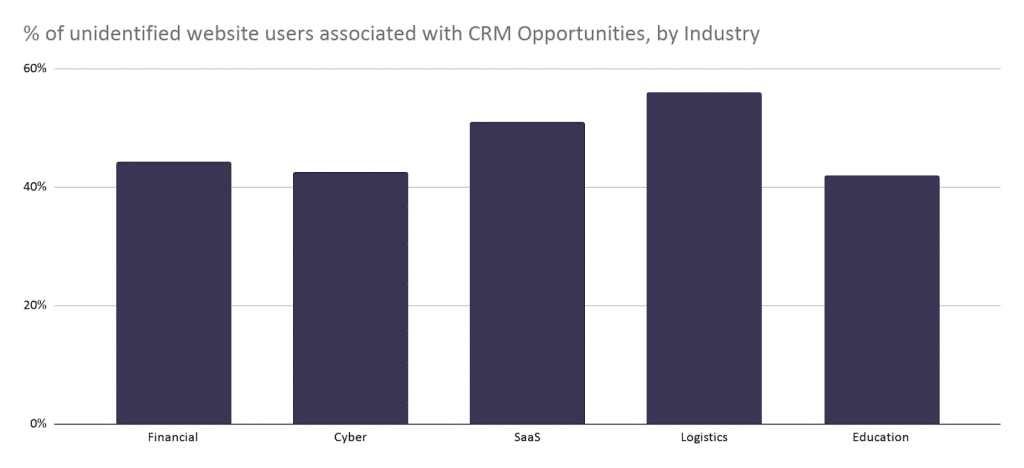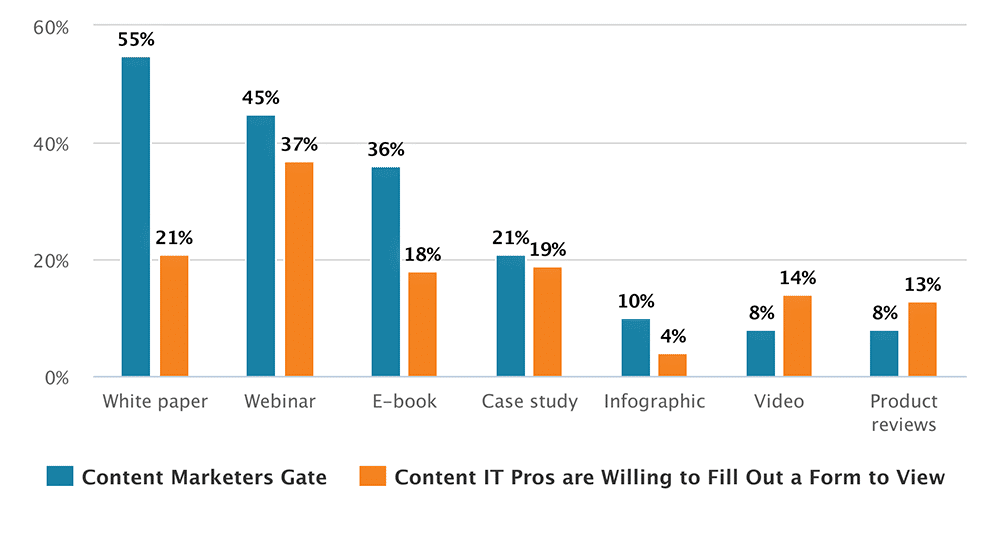Enterprise marketers, half of your buyer journeys are in the dark

Feedback is the lifeblood of marketing. Without a proper feedback loop, it’s hard, almost impossible, for marketers to know whether their efforts are bearing fruit. When we started Trendemon, we seeked to answer What is the ROI of Content Marketing. It was that blindness content marketers suffered from, not knowing how their creative efforts impacted revenue, which prompted us to search for a solution. Today, we see enterprise marketers plagued by another blindness, but one that we’re not sure most are aware of. In the following post we’ll share new data about the blindness of enterprise marketers to the majority of relevant buyer journeys which engage with their assets. But it’s not all bad news. We’ll try and show how, by removing this blindness and closing the loop, b2b marketers can grow beyond revenue attribution and step into the realm of revenue acceleration and revenue acceleration platforms. This topic also relates to the age old b2b marketing question – To gate or not to gate your content, and if so, how and how much.
Dark Journeys vs. Known Visitors
Identified visitors are those that at some point of their journey agreed to submit their email and personal information in exchange for an interesting whitepaper or to view a webinar. Unidentified users are those that left no personally identifiable information. Out of those people, some are from companies who are potential customers but haven’t materialized into sales opportunities. Some, however, are people from companies that do exist in the CRM in the form of sales opportunities. That last group is at the center of this analysis.
The Revenue Attribution Challenge – On the surface, it would appear that B2B marketers, as opposed to brands marketers, usually have more visibility at how their activities are impacting sales. They also have more platforms, like marketing automation integrated with CRM, which enable them to follow their progress more closely. However, despite the abundance of technology at their disposal, they are still plagued by several major blind spots. One of those blind spots is the ability to clearly show how their combined efforts impact revenue and pipeline. We’re not only talking about connecting which campaign or event initially brought the deal, but a more holistic view of the entire journey of the deal. In account based marketing, this blindspot is even greater, as you have multiple individuals from every company engage with your digital assets. Removing this blindness is also the first part in achieving revenue acceleration.

Moving beyond mapping the journey of the buyer to mapping the journey of the deal
Over the past year, we have been taking a closer look at the connections between journeys, accounts, pipeline and revenue. We looked at anonymized data from dozens of ABM and B2B marketing teams, addressing different markets, verticals, deal sizes and buyers personas.

As we were analyzing the data, we came across something that at first looked like a mistake. 42%-58% of the journeys associated with opportunities (companies) at different stages were not connected with any email address. Although their journeys were impacted by content marketing, those engagements were not measured and recognized as contributing to the deal. The marketing organization, especially in ABM scenarios, may have achieved its goal of engaging relevant people from key accounts. However, their contribution couldn’t be attributed since the users from those companies weren’t connected at the opportunity level.

As we broke this data down, other patterns emerged. In many of the higher value deals, the ratio of identified vs. unidentified users of the digital assets was higher (a greater number of unidentified users in each opportunity). That makes sense as in many high-ticket deals you would see more people from the same organization visiting the website but a smaller percentage that would leave their contact info. We also saw that the journey lengths and number of pages between identified and unidentified users did not vary greatly. That was actually surprising since we assumed that the more engaged users would be identified. That could indicate that a large percentage of engaged users does not want to submit their emails, yet wants to consume relevant content.
We saw that these numbers also remained consistent between companies that relied more on gated content than those that didn’t. It would appear that many relevant users are reluctant to submit their personal information as part of the gating process but are interested in learning more about the company’s offerings or ideas.
What does this mean for B2B/ABM Marketing Teams:
2 initial observations from this data:
- On Open Loop – Going back to the point we started with, this gap in identification can pose a major challenge to the marketing feedback loop. Since many of the relevant journeys are unaccounted for, the attribution of content marketing to outcomes and opportunities can be significantly skewed off. This attribution gap can lead to erroneous ROI calculations, falsely indicating that valuable activities and campaigns, did not yield the desired results. Pages that did engage users from relevant opportunities, would not appear as contributing while other pages would get a greater weight.
- To Gate or Not to Gate – The email address is still a cornerstone of b2b marketing. Many marketers still regard it as the first stage of the engagement process. They gate much of their content marketing assets as a way to coerce visitors to leave their contact details. However, the data shows that many relevant visitors are not willing to step through those gates. This poses a dual challenge for the company – 1) The marketing team is unable to nurture these prospects with email marketing. 2) The sales team cannot directly engage those individuals. One way to address the first challenge is though ABM based personalization and revenue acceleration platforms. By serving the right content to visitors from certain companies, you can at least maintain some form of journey, even without the need to force them through the gated content. As for the second challenge, sales and sales development teams will need to adapt to situations, which are becoming more common, of prospects willing to openly engage only at later stages of their buyer journey. As their intent becomes apparent, they would be more willing to step into the light.
Spiceworks carried out this survey among IT pros asking which content they’d be willing to provide their emails in order to view. This survey shows that although marketers commonly use gates for whitepapers, IT pros were less inclined to fill forms in order to view them:

From forcing audiences through gates, to inviting them through open doors
For more on this ongoing debate of how much of your content should be gated, see this post by content marketing titan Robert Rose – https://contentmarketinginstitute.com/2020/07/gated-content-audience-journey/ .
To paraphrase, Rose describes 2 main actions that content can drive: building an audience and moving people through their buyer’s journey. In the first goal, of building the audience, you focus on providing free, untethered access to valuable content. If an engaged audience member wishes to continue receiving content from you in the future, they sign up. Their subscription does not indicate a movement along the buyer axis but along the attention axis. If and when, they are ready to move along the buyer axis, then you can place gated assets.
Do not confuse attention with intention.
The fact that someone subscribed to your ideas, does not indicate they are also ready to buy your product.
“You don’t build audiences with gated #content, you move them, (hopefully)”
@Robert_Rose via @CMIContent.”
Overcoming this blindness – Key Questions & Solutions
1. Use an ABM platform to deanonymize visits from relevant companies. Can you identify from which companies people are visiting your site? There are several vendors which can help you deanonymize your traffic like Netfactor, DemandBase or Kickfire. Ensure you can connect on site journeys to CRM opportunities. Make sure you can follow user journeys that pass through your site down to the sales opportunity level. See that you can view where they originated from, which assets they engaged with and with which CRM deals they are associated with.
2. Revenue Attribution – The ability to connect your assets and efforts to opportunities. Can you see which pages, domains, assets (gated or not), sources and campaigns are associated with deals in the various stages? Are you able to carry out a proper content marketing impact analysis? measure content marketing roi? Even without diving deep into attribution models and complex systems, you should be able to view the participation of assets in journeys.
3. From revenue attribution systems to revenue acceleration platforms. Once the blindfold has been removed, what can you do to accelerate the movement of relevant users through your assets? If you don’t have their email, then email marketing nurturing is out the door. However, personalization platforms (like Trendemon for content, Drift for conversations or others) that are connected to the ABM data and user journey. Another aspect which can help overcome the Dark Journeys Problem is remarketing. By tagging relevant visitors, you can also move to engage them beyond the website.
All of these capabilities are not solutions to a problem. They are mitigations to a symptom. Marketers should first asks themselves whether their audience is growing. Then, whether members of that audience are also potential buyers. Lastly, when those potential buyers are ready to step into the light, you are able to provide the right experience for them to transition into that new stage of their journey. In the coming weeks we will unveil our new Revenue Acceleration Platform which will help address many of the above issues so stay tuned.
To download the complete analysis, just leave your contact information in the following gated form:
.
.
.
.
.
…Just kidding 🙂
We do hope to share more data on this subject in the coming weeks, free and open. If you do wish to follow our posts, you are welcome to subscribe to our newsletter below. If or when you’d like to connect and learn more about our Revenue Acceleration Platform, you can do so here.